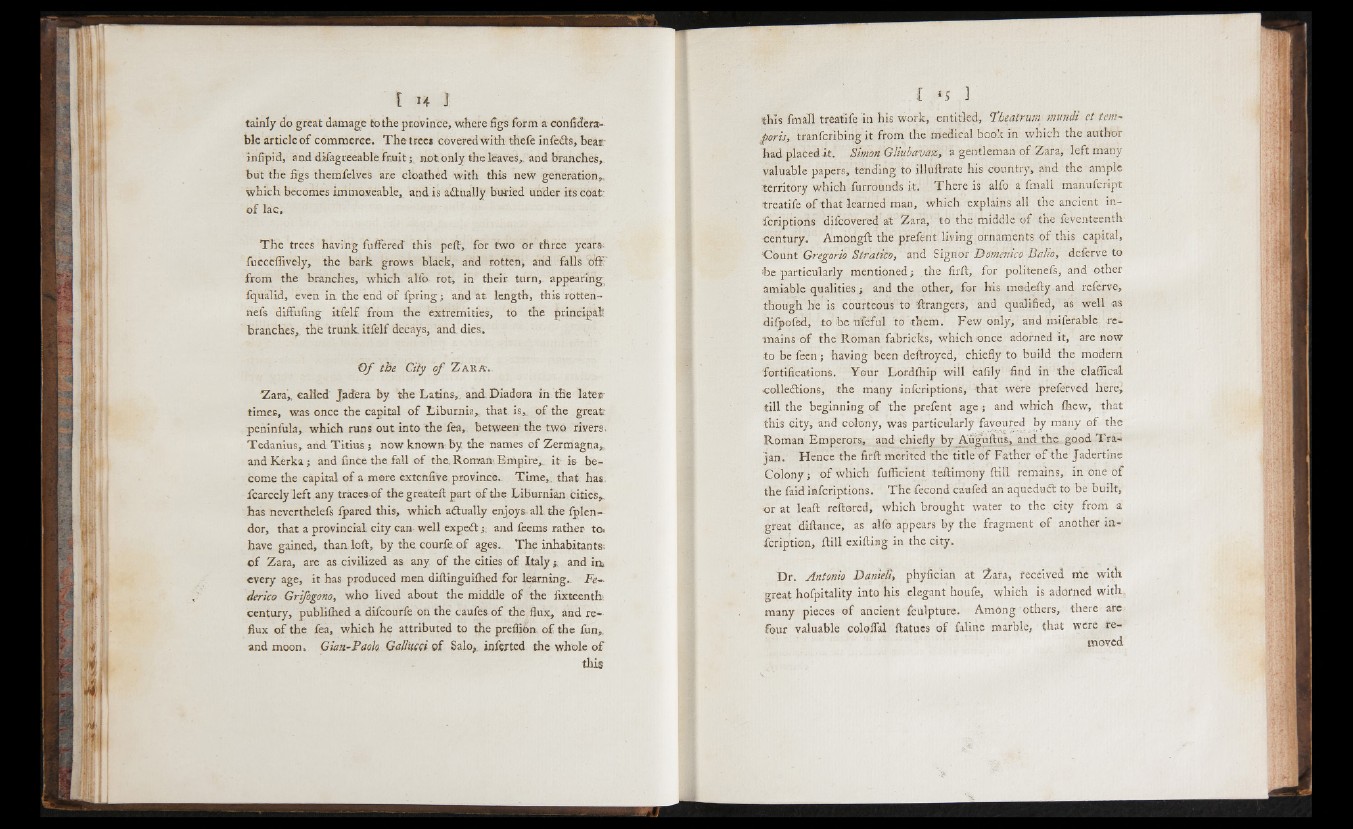
tainly do great damage to the province, where figs form a considerable
article o f commerce. The tree* covered with thefe infects, bear
infipid, and difagreeable fruit; not only the leaves,, and branches,,
but the figs themfelves ar.e cloathed with this new generation,,
which becomes immoveable, and is actually buried under its coat
o f lac.
The trees having fuftered this peft, for two Or three years;
fucceffively, the bark grows black, and rotten, and falls off'
from the branches, which alfo rot, in their turn,, appearing^
fqualld, even in. the end o f fpring; and at length, this rotten-
nefs diffufing itfelf from the extremities, to the principal
branches, the trunk, itfelf decays, and dies.
O f the City o f Z ahav
Zara, called Jjadera by die Latins,, and Diadora in the later
times, was once the capital o f Liburnia, that. is,, o f the great;
peninfula, which runs out into the fea,. between the two rivers,
Tedanius, and Titius ; now known: by the names of Zermagna,.
andKerka; and fince the fall o f the, Roman Empire,, it is become
the capital o f a mere extenfive province.. Time,, that has.
fcarcely left any traces of thegreateil part of the LiBurnian cities,
has neverthelefs Ipared this, which actually enjoys, all the fplen-
dor, that a provincial city can well e x p e c ta n d feems rather to„
have gained, than loft, by the courie.of ages. The inhabitants;
o f Zara, are as civilized as any o f the cities o f Italy and in,
every age, it has produced men diftinguifhed for learning, Fe~
¿erico Grifogono, who lived about the middle of the fixteenth
century, publifhed a difcourfe on the caufesof the flux, and reflux
o f the fea, which he attributed to the preflibn o f the fun,
and moon. Gian-Paolo Gallucct of Salo, inierted the whole o f
this
. C l $ 1
this finall treatife in his work, entitled, ‘Theatrum mun£ et tern-
fo r is, tranfcribing it from the medical book in which the author
had placed it. Simon Gliubavaz, a gentleman of Zara, left many
valuable papers, tending to illuftrate his country, and the ample
territory which furrounds it. There is alfo a fmall manufcript
treatife o f that learned man, which explains all the ancient infcriptions
difcovered at Zara, to the middle o f the feventeenth-
century. Amongft the prefent living ornaments o f this capital,
Count Gregorio Stratk'o, ' and Signor Domenico Balio, deferve to
he particularly mentioned, the firft, for politenefs, and other
amiable qualities ; and the other, for his modefty and referve,
though he is courteous to ftrangers, and qualified, as well as
difpofed, to he fifeful to them. Few only, and milerable remains
o f the Roman fabricks, which once adorned it, are now
to be feen; having been deftroyed, chiefly to build the modern
fortifications. Your Lordlhip will eafily find in the claffical
.collections, the many infcriptions, that were prefefved here,
till the beginning o f the prefent age -; and which fhew, that
this city, and colony, was particularly favoured by many o f the
Roman Emperors, and chiefly by Auguftus, and the good Trajan.
Hence the firft merited the title o f Father o f the Jadertine
Colony; o f which fufficient teftimony ftill remains, in one o f
the faid infcriptions. The fecond caufed an aqueduct to be built,
or at leaft reftored, which brought water to the city from a
great diftance, as alfo appears by the fragment o f another in-
fcription, ftill exiting in the city.
Dr. Antonio Danieli, phyfician at Zara, received me with
o-reat hofpitality into his elegant houfe, which is adorned with,
many pieces o f ancient fcdlpture. Among others, there are
four valuable colofial ftatues o f faline marble, that were removed